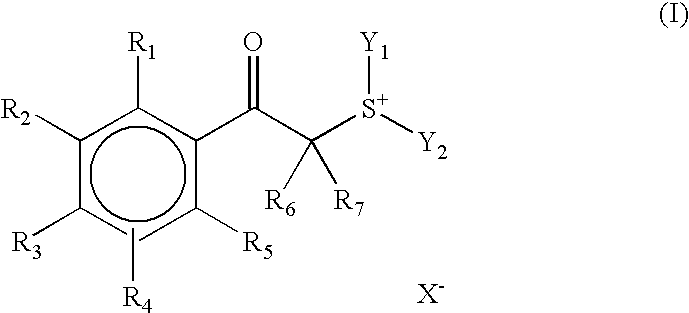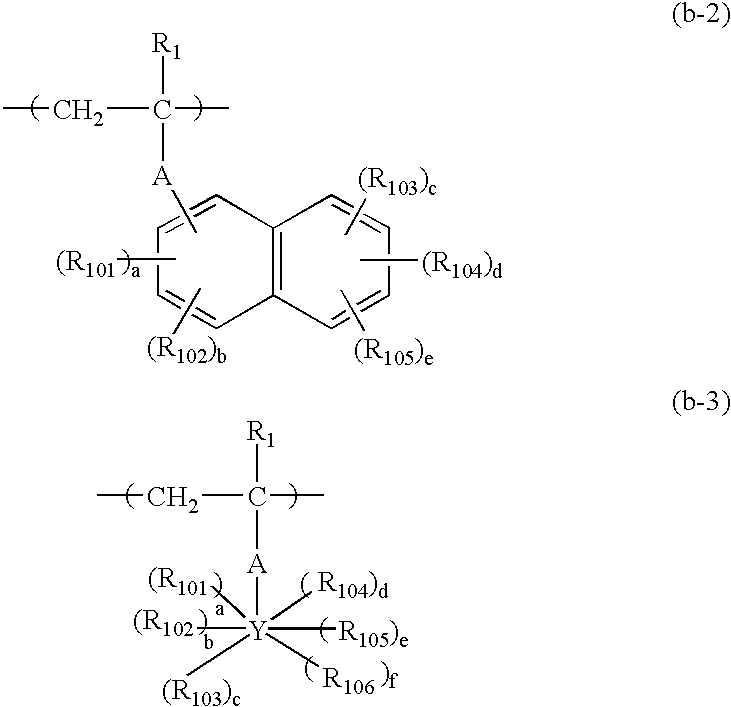Negative resist composition
a technology of composition and resist, applied in the field of negative resist composition, can solve the problems of increasing the sensitivities of materials, aggravating line edge roughness, deteriorating pattern profiles, etc., and achieves the effects of enhancing microlithography performance, high sensitivity, and high resolution
- Summary
- Abstract
- Description
- Claims
- Application Information
AI Technical Summary
Benefits of technology
Problems solved by technology
Method used
Image
Examples
synthesis example 1
Synthesis of Acid-Generator (1-1)
[0215]To a mixture of 16.4 g of AgBF4 with 150 ml of acetonitrile, a solution containing 16.0 g of phenacyl bromide and 12.4 g of di-n-butyl sulfide in 50 ml of acetonitrile was added over a period of 30 minutes. After stirring for one night at room temperature, the reaction solution was concentrated to deposit a powder. The powder was washed with diisopropyl ether to give 27 g of phenacyldi-n-butylsulfonium tetrafluoroborate.
[0216]The phenacyldi-n-butylsulfonium tetrafluoroborate in an amount of 10 g was dissolved in 200 ml of methanol, and thereto 10.1 g of potassium nonafluorobutanesulfonate was added and stirred for one hour at room temperature. The reaction solution thus obtained was mixed with 500 ml of chloroform, and washed with two 300 ml portions of distilled water. The organic layer was concentrated to yield 9.8 g of an acid generator (1-1).
[0217]The other compounds were synthesized in similar manners to the above.
2. EXAMPLES
example 1
(1) Preparation and Coating of Negative Resist Solution:
[0218]
Resin (29) (Component (A))0.70 gCross-linking agent MM-1 (Component (B))0.25 gAcid generator I-1 (Component (C))0.05 g
[0219]The above ingredients were dissolved in 8.5 g of propylene glycol monomethyl ether acetate, and therein 0.002 g of OE-1 as Component (D) was mixed and dissolved. Further therein, 0.001 g of Megafac F176 (a product of Dainippon Ink & Chemicals, Inc., hereinafter abbreviated as “W-1”) as a surfactant was mixed and dissolved. The solution obtained was subjected to fine filtration with a membrane filter 0.1 μm in pore diameter, thereby preparing a negative resist solution.
[0220]The thus prepared negative resist solution was coated on a 6-inch wafer by means of a spin coater Mark 8 made by Tokyo Electron, and dried for 90 seconds on a 110° C. hot plate to form a resist film having a thickness of 0.3 μm.
(2) Formation of Negative Resist Patterns:
[0221]The resist film is irradiated with an electron-beam draw...
examples 2 to 30
[0227]Using various combinations of ingredients as shown in Tables 1 to 3, negative resist solutions were prepared and negative patterns were formed in the same manner as in Example 1. The evaluation results are shown in Tables 4 and 5.
PUM
| Property | Measurement | Unit |
|---|---|---|
| roughness | aaaaa | aaaaa |
| molecular weight distribution | aaaaa | aaaaa |
| molecular weight distribution | aaaaa | aaaaa |
Abstract
Description
Claims
Application Information
 Login to View More
Login to View More - R&D
- Intellectual Property
- Life Sciences
- Materials
- Tech Scout
- Unparalleled Data Quality
- Higher Quality Content
- 60% Fewer Hallucinations
Browse by: Latest US Patents, China's latest patents, Technical Efficacy Thesaurus, Application Domain, Technology Topic, Popular Technical Reports.
© 2025 PatSnap. All rights reserved.Legal|Privacy policy|Modern Slavery Act Transparency Statement|Sitemap|About US| Contact US: help@patsnap.com



